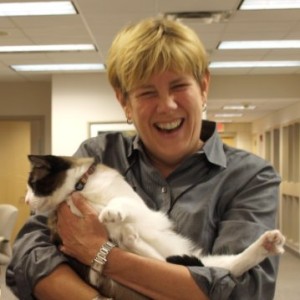When the Cleveland Animal Protective League got hit with nearly 150 cats from a hoarding situation last January, most with serious health problems, they knew it was a challenge they didn’t have to face alone.
“All these cats had been living in a free-roaming environment, and we found we had some FIV and FeLV, some giardia, and ringworm,” said Cleveland APL director Sharon Harvey. “They’d been exposed to everything! There was a time when none of those cats would have gone through our system with all of that exposure, but we were committed to coming up with good outcomes for all of them. The problem was, we don’t have anywhere to easily put 150 cats.”
Harvey reached out to the director of the Friendship Animal Protective League in nearby Elyria, Ohio, which took 30 of the cats, something she says would never have happened if the two shelters weren’t part of a longstanding but informal coalition of the region’s animal shelters. “Here was a friend who, through these meetings, had also built up the trust that we weren’t unloading a bunch of undisclosed headaches that we wouldn’t help with once the cats were off our hands,” Harvey said. “And I knew these cats were going to a good place. It was a true partnership.”
The meetings began while Harvey was director of the Geauga Humane Society, where she served for four years before taking over at the Cleveland APL. “It became clear we needed to talk among ourselves,” she said. “There was a lack of trust between different kinds of groups, no one was working together, and forget collaboration — for most of us, there was a lack of interest in working together, and even some hostility.”
The get-togethers included all the directors of private shelters in Cuhahoga County and its neighbors, but soon spread to include municipal dog wardens from the area, too. They met monthly, sharing experiences, ideas, concerns and opportunities both large and small.
“It seems like a minor thing, but one of the resources most shelters desperately need more of is paper towels,” Harvey said. “We were offered the donation of an entire truckload of them from Bounty, but we had nowhere to store them. By sharing the donation with all the partners in our informal group, all our animals were able to benefit.”
On a bigger scale, one of the issues the group has tackled is setting up a dog transfer program between the municipal and private shelters. “We still have a long way to go, but we’ve seen spay/neuter rates go up, intake down, live release rates go up and transfers boom,” Harvey said. “I’m not saying that’s all just because of the meetings, because those things have happened in other places, but I believe some of these improvements wouldn’t have happened.”
The group has now been meeting for 11 years, and has seen a lot of turnover during that time. “As each new leader comes in, they’re invited, and we’ve found it to be a great way to help these new leaders adjust and learn what’s going on in our community,” she said. “I think that sets new leaders up to be more successful earlier in their tenure, because they have information I’m not sure would otherwise be so readily available, and the support of colleagues.”
Can their model help other communities? “I think what a lot of people think is the last thing we need is another meeting during the month,” Harvey said. “And others wonder, if you’re not going to have a formal coalition, how do you deal with things like data and ground rules? But what I’d tell people is this: If you don’t think you have the bandwidth to get formal, just start with this. Get to know each other. Get together. Work together informally. The rest can fall into place.
“Always pushing formal coalition building might turn some people away,” she said. “But we’ve all got to eat lunch sometime, so let’s sit down and have lunch together and do this!”

